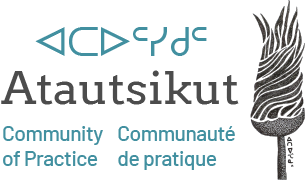
Ressources des rencontres Atautsikut
Références utilisées
- Brave Heart., & DeBruyn, L. M. (1998). The American Indian holocaust: Healing historical unresolved grief. American Indian and Alaska native mental health research, 8(2), 56-78
- Brillon, P. « Fatigue de compassion et trauma vicariant. Quand la souffrance de nos patients nous bouleverse », Psychologie Québec, vol. 30, n° 3, mai 2013, p. 30-35.
- Chrestman, K. « Secondary exposure to trauma and selfreported distress among therapists », dans B. Stamm (ss la dir. de), Secondary Traumatic Stress: Self-Care Issues for Clinicians, Researchers and Educators (2e éd.), Lutherville (MD), The Sidran Press, 1995, p. 29-36
- Carter, R. T. (2007). Racism and psychological and emotional Injury: Recognizing and assessing race-based traumatic stress. The Counseling Psychologist, 35, 13-105.
- Cook A, Spinazzola J, Ford J, Lanktree C, et al. Complex trauma in children and adolescents (2005). Psychiatr Ann, 35(5):390–8.
- de Leeuw, S., Greenwood, M. et Cameron, E. (2010). Deviant constructions: How governments preserve colonial narratives of addictions and poor mental health to intervene into the lives of Indigenous children and families in Canada. International Journal of Mental Health and Addiction, 8(2), 282-295.
- Elliott, D. E., Bjelajac, P., Fallot, R. D., Markoff, L. S., & Reed, B. G. (2005). Trauma‐informed or trauma‐denied: Principles and implementation of trauma‐informed services for women. Journal of community psychology, 33(4), 461-477
- Fraser, S. L., Geoffroy, D., Chachamovich, E. et Kirmayer, L. J. (2015). Changing Rates of Suicide Ideation and Attempts Among Inuit Youth: A Gender‐Based Analysis of Risk and Protective Factors. Suicide and Life‐Threatening Behavior, 45(2), 141-156.
- Gone, J. P., Hartmann, W. E., Pomerville, A., Wendt, D. C., Klem, S. H. et Burrage, R. L. (2019). The impact of historical trauma on health outcomes for indigenous populations in the USA and Canada: A systematic review. American Psychologist, 74(1), 20.
- Healey, G. K., Noah, J. et Mearns, C. (2016). The Eight Ujarait (Rocks) model: Supporting Inuit adolescent mental health with an intervention model based on Inuit ways of knowing. International Journal of Indigenous Health, 11(1), 92-110.
- Hernández, P., Gangsei, D., & Engstrom, D. (2007). Vicarious resilience: A new concept in work with those who survive trauma. Family process, 46(2), 229-241
- Herman, J. L. (1992). Complex PTSD: A syndrome in survivors of prolonged and repeated trauma. Journal of traumatic stress, 5(3), 377-391
- Inuit Tapiriit Kanatami (ITK). (2014). Social determinants of Inuit health in Canada.
- Inuit Tapiriit Kanatami (ITK). (2016). National Inuit suicide prevention strategy.
- Kirmayer, L. J., Rousseau, C., Jarvis, G. E. et Guzder, J. (2008). The cultural context of clinical assessment. Psychiatry, 3, 54-66
- Kirmayer, L. J., Dandeneau, S., Marshall, E., Phillips, M. K. et Williamson, K. J. (2011). Rethinking resilience from indigenous perspectives. The Canadian Journal of Psychiatry, 56(2), 84-91.
- Menzies, P. (2010). Intergenerational trauma from a mental health perspective. Native Social Work Journal,7, 63-85.
- Oliver, L. N., Peters, P. A. et Kohen, D. E. (2012). Mortality rates among children and teenagers living in Inuit Nunangat, 1994 to 2008. Health Rep, 23(3), 17-22.
- Mikkonen, J. (2010). The Canadian facts. Toronto, ON: York University School of Health Policy and Management
- Paradies, Y. (2016). Colonisation, racism and indigenous health. Journal of Population Research, 33(1), 83-96
- Trout, L., McEachern, D., Mullany, A., White, L. et Wexler, L. (2018). Decoloniality as a framework for indigenous youth suicide prevention pedagogy: Promoting community conversations about research to end suicide. American journal of community psychology, 62(3-4), 396-405.
- Wesley-Esquimaux, C. et Smolewski, M. (2004). Historic Trauma and Aboriginal Healing. Ottawa, ON: Aboriginal Healing Foundation.ilies in Canada. Journal of palliative care, 26(1), 6-14.
- American Psychiatric Association (2000). Diagnostic and Statistical Manual of Mental Disorder (4th ed., text rev.). Washington, D.C.: Author.
- Blaustein M, Kinniburgh K. Treating traumatic stress in children and adolescents: how to foster resilience through attachment, self- regulation, and competency (2010). New York: Guildford Press.
- Cloutier, L., Corbeil, D. & Lamarche, G. (2002). Guide d’intervention scolaire suite à une tragédie ou un sinistre. Commission scolaire de la Rivière-Nord, janvier 2022. 86 pages.
- Duran, E., & Duran, B. (1995). Native American postcolonial psychology. Suny Press
- Harvey, M. R. (1996). An ecological view of psychological trauma and trauma recovery. Journal of traumatic stress, 9(1), 3-23
- Herman, J. Trauma and recovery (1992). New York (NY), Harper Collins.
- Hopper, E. K. (2017). Trauma-informed psychological assessment of human trafficking survivors. Women & Therapy, 40(1-2), 12-30.
- Lewis-Fernández R, Aggarwal NK, Hinton L, Hinton DE, and Kirmayer LJ, eds. DSM-5 Handbook on the Cultural Formulation Interview. Arlington, VA: American Psychiatric Publishing. 2016
- Rothschild, B. et M. Rand. Help for the Helper: The Psychophysiology of Compassion Fatigue and Vicarious Trauma, New York (NY), WW Norton & Company, 2006, 272 p.
- Smylie & Firestone (2016). The Health of Indigenous Peoples. In Raphael (ed) Social determinants of Health: Canadian Perspectives. p.451
- Quijano, A. (2007). Coloniality and modernity/rationality. Cultural studies, 21(2-3), 168-178.
- Yellow House Brave Heart, M. (2003). The historical trauma response among natives and its relationship with substance abuse: A Lakota illustration. Journal of psychoactive drugs, 35(1), 7-13.




